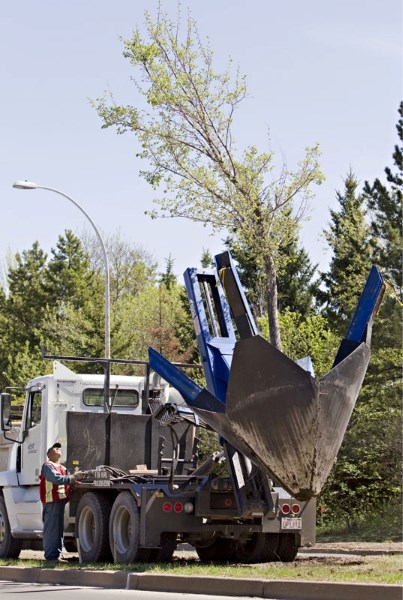And so ends the long winter of our discontent, tree-lovers — the forest has returned to Boudreau Road.
City crews took the axe to about 58 large poplar trees along Boudreau this winter. The trees, most of which were dead or dying, were removed as part of the city’s poplar removal program, eliminating the street’s once-thick canopy.
That was a shock to many people, says city operations supervisor Mike Jones, so the city wants to get the trees back as soon as possible. Crews are now planting about 150 trees along the middle and sides of Boudreau Road and should have the middle island of the street reforested by next week. “We’re replacing all those trees we took out.”
Crews are planting large elms along the middle of the street to restore the canopy created by the poplars, Jones says. Elms have deep roots that make them more stable than poplars, and branches that grow up rather than out, which will keep the trees away from traffic. These trees are about twice as big as the ones the city would normally plant (100 millimetres in diameter, compared to 50), and should live for about 80 years. “Probably in another 15 years the canopy will be quite dramatic.”
Elms are vulnerable to Dutch elm disease, an elm-killing fungus transmitted by bark beetles, but Jones was confident that the city’s monitoring program would keep these trees safe from it. “The fear of planting elms isn’t as great as it was 10 years ago.”
The last confirmed case of Dutch elm disease in Alberta was in 1998, according to Alberta Agriculture, and involved one tree in Wainwright.
The sides of the street will be populated with blue spruce, pine and lilacs, Jones says. He’s still waiting for some of these to be delivered, but he hoped to have them in place before the end of summer. “Hopefully, we’ll get some good reviews out of it.”
About 270 other boulevard trees will also be replaced throughout the city this summer.
About 320 poplars were removed from city boulevards this winter. For details, call Jones at 780-459-1557.
Almost 500 people swarmed downtown St. Albert last week to clean and green the Sturgeon, according to organizers, setting a new attendance record.
The city held its annual Clean Up the Sturgeon event in conjunction with the seventh annual River Edge Enhancement Project (REEP) planting on May 15.
Both were huge successes, says community recreation co-ordinator Erin Gluck. An all-time high of 476 people registered for the clean-up, or about 100 more than last year. “We’re kind of blown away.”
Volunteers managed to sweep pretty much every spot along the river as well, Gluck says, as Lacombe Lake Park and other local ravines — often more than once, as the wind blew in more trash. They collected about 1.15 tonnes of trash, considerably more than last year’s 0.7 tonnes.
About 300 of those registrants also planted trees as part of REEP, an ongoing project to bring plants and animals back to the banks of the Sturgeon. Participants planted about 354 trees and shrubs on the banks of the river just west of St. Albert Centre and took about 200 seedlings to grow at home.
It was the biggest REEP turnout yet, says REEP committee chair Nicholas Batchelor. “What was really great to see was the participation we had from the community,” he adds, which included volunteers from schools such as Paul Kane, Bellerose and St. Albert Catholic High School. “We need to create the awareness amongst the community of St. Albert that, hey, our river valley needs to be protected.”
NAIT students would present an evaluation of the REEP program to council sometime this fall, Batchelor says.




